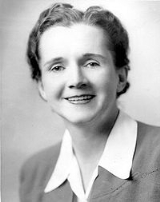
and conservationist
whose writings are credited with advancing the global environmental movement
.
Carson began her career as a biologist in the U.S. Bureau of Fisheries
, and became a full-time nature writer in the 1950s. Her widely praised 1951 bestseller The Sea Around Us
won her financial security and recognition as a gifted writer. Her next book, The Edge of the Sea
, and the republished version of her first book, Under the Sea Wind, were also bestsellers.
The aim of science is to discover and illuminate truth. And that, I take it, is the aim of literature, whether biography or history or fiction. It seems to me, then, that there can be no separate literature of science.![]()
We have been troubled about the world, and had almost lost faith in man; it helps to think about the long history of the earth, and of how life came to be. And when we think in terms of millions of years, we are not so impatient that our own problems be solved tomorrow. ![]()
I like to define biology as the history of the earth and all its life — past, present, and future. To understand biology is to understand that all life is linked to the earth from which it came; it is to understand that the stream of life, flowing out of the dim past into the uncertain future, is in reality a unified force, though composed of an infinite number and variety of separate lives.![]()
Any concept of biology is not only sterile and profitless, it is distorted and untrue, if it puts its primary focus on unnatural conditions rather than on those vast forces not of man's making that shape and channel the nature and direction of life.![]()

